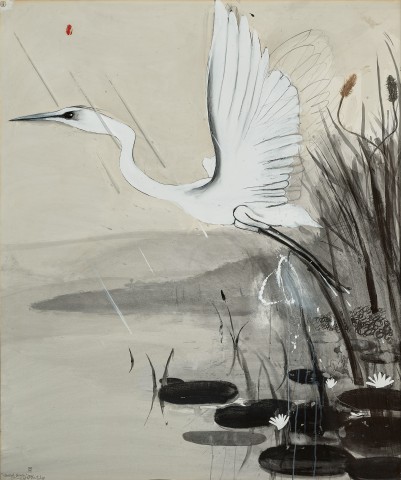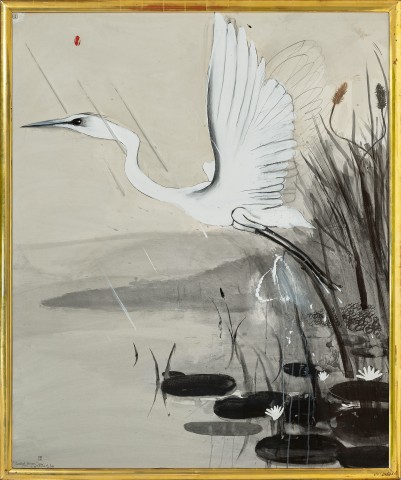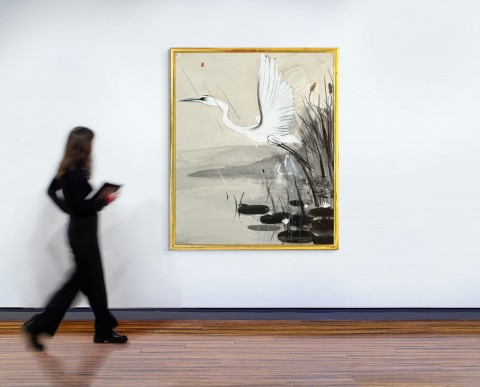(1939 - 1992)
Brett Whiteley
Startled heron, 1984
charcoal, ink, gouache and collage on paper on board (with white oil on Perspex surface)
Australian Galleries, Melbourne, 1984 (label attached verso, AG7093)
Private collection
Sotheby's, Melbourne, 19 August 1991, lot 319
Private collection, Melbourne
An Exhibition by Brett Whiteley - Eden and Eve, Australian Galleries, Melbourne, Melbourne 1984, cat. 43
Sutherland, K., Brett Whiteley: Catalogue Raisonné, Schwartz Publishing, Melbourne, 2020, cat. 173.84, vol. 4, p. 281 (illus.), vol. 7, p. 643
Untitled (Heron, Rain and Wind), 1973, oil and mixed media (bird’s nest and egg) on board, 85.5 x 82.0 cm, private collection, illus. in Sutherland, K., Brett Whiteley: Catalogue Raisonné, Schwartz Publishing, Melbourne, 2020, vol. 3, p. 183
Shao (Rain Slanted by Wind), 1978 - 79, oil, nest and birds' eggs on board, 122.0 x 81.0 cm, private collection, illus. in Sutherland, K., Brett Whiteley: Catalogue Raisonné, Schwartz Publishing, Melbourne, 2020, vol. 3, p. 566
First presented within a large solo exhibition, Eden and Eve, at Australian Galleries in Melbourne, alongside lyrical landscapes of native birds nesting in trees, panoramas of the suburban Australian dream under laden grey skies and radiant beach scenes, Startled heron, 1984 joins expressions of Brett Whiteley’s conception of the landscape and natural world as a sanctuary. The bird held special appeal for Brett Whiteley throughout his extensive and varied career, frequently appearing in his most significant compositions. Beyond their physical shapeliness, for Whiteley, birds symbolised states of mind, the promise of escapism and freedom in the face of adversity.1 Lauded as ‘Australia’s most sublime painter of birds’2, Whiteley has captured here, in graceful, swift motions, the striking silhouette of a white heron taking flight headlong into the rain.
The heron first appears in Whiteley’s oeuvre in The pink heron, 1969 (Art Gallery of New South Wales). Calmly gliding over surging waves illuminated by the moon, The pink heron, like many of Whiteley’s luxuriant bird paintings, was painted in Fiji, where the artist had travelled in search of a place of Baudelairean tranquillity and happiness after the disillusionment of his American dream. Subsequent compositions featuring the heron, painted throughout the 1970s and 80s, emphasised the formal qualities of the bird’s pale plumage and elegant sinuous silhouette. In Startled heron, the smooth charcoal and ink arabesques of Whiteley’s characteristic freehand brushstrokes, stark against a watery landscape fringed by bulrushes, reveal the artist’s familiarity and facility with Asian painting techniques and his longstanding admiration for Asian cultures at a time when the Australian government was not yet prioritising Asia-Pacific relations.3 Whiteley’s enthusiastic adoption of the meditative process of brush-and-ink Japanese Sumi-e calligraphy, capturing the essence of nature, was underpinned by his admiration for Zen Buddhist philosophy. Whiteley described Zen as the ‘theology of drawing’4, its application requiring the utmost confidence, mindfulness and restraint. The resulting works bear a spontaneous and fluid quality, lyrically balancing deep black inks in all possible graduations with large areas of negative space. In contrast to other depictions of the heron taking flight within Whiteley’s oeuvre: Untitled (Heron, rain, wind) 1973 (private collection) and Shao (Rain slanted by wind), 1978 – 79 (private collection), the startled heron here soars not from a physical nest bearing eggs glued to the canvas, but a broader, painted landscape of a river bank, atmospherically and melancholically grey. The romanticism of driving rain became a key feature of Whiteley’s heron paintings, as exemplified by the Mandarin Chinese character shào used in the title of related works.
This serene composition is almost entirely monochromatic, with only the russet brown of the bulrushes’ spike, the bright red Chinese stamp bearing Whiteley’s name, and collaged waterlily blooms breaking the modulated tones of ink and charcoal. The soft, pearly grey of the water and sky appears almost as a continuous plane, only separated by a faintly brushed line of the horizon. While the landscape is silent and still, the bird’s dramatic take-off provides the narrative drama for this scene, a glimpse of unexpected majesty for a bird most often seen standing still in marshes (as in The white heron, c.1980, Brett Whiteley Studio Collection). With splatters of pure white paint dripping across the picture plane and feathers doubled in pencil, the dynamism and controlled force of the bird’s sudden flight are skilfully made apparent by the artist. The heron confidently sets out into the rain, which falls diagonally across the canvas in the same direction, painted onto the surface of the perspex to express the birds’ imperviousness to the elements. Overlaid on a velvety grey sky, this artistic conceit was used often in Whiteley’s works of the period, frequently in conjunction with the landscape as viewed through a windowpane, the promise of shelter implicit. The contemporaneous South coast after rain, 1984 (private collection) – winner of the Wynne prize for landscape painting (awarded to Whiteley for the third time) – is perhaps the best-known example of this technique.
Divinely connoting purity, transition and good fortune in Japanese art, the heron also appeared in Whiteley’s oeuvre in sculptural form in 1983 as a plaster maquette painted white. Created during a tumultuous time in Whiteley’s personal life, directly preceding a return to rehab in July 1984, Startled heron expresses tender hope and determination, the noble search for comfort and freedom. As Alan McCulloch noted in 1970, the enduring acclaim of Whiteley’s paintings of birds lies in the fact that the artist was motivated by love.5
1. Artist statement, exhibition catalogue, Birds and Animals, Robin Gibson Gallery, 1979
2. Pearce, B., Australian Artists, Australian Birds, Angus & Robertson, Sydney, 1989, p. 144
3. McGrath, S., Brett Whiteley, Bay Books, Sydney, 1979, p. 71
4. ibid. p. 168
5. McCulloch, A., Letter from Australia, Art international, October 1970, pp. 69-70
LUCIE REEVES-SMITH


